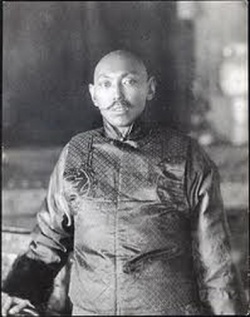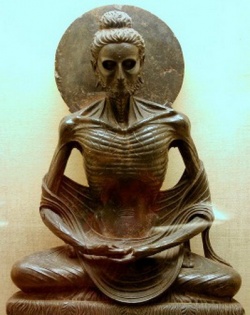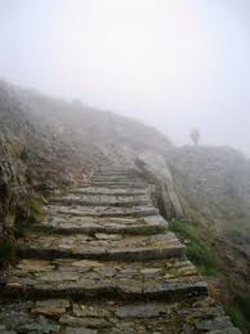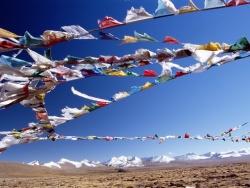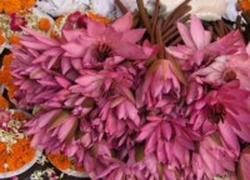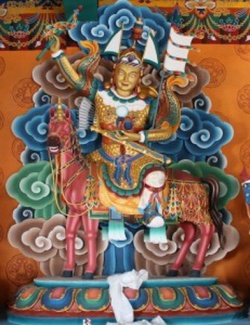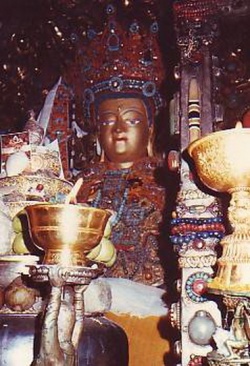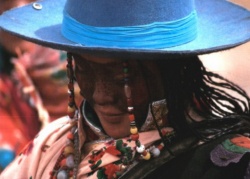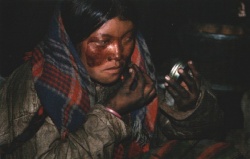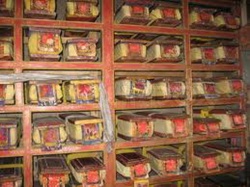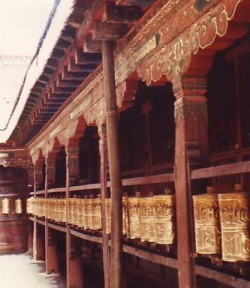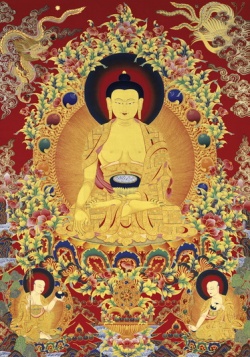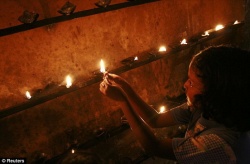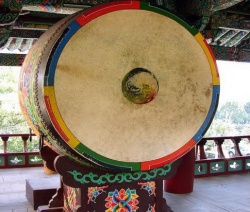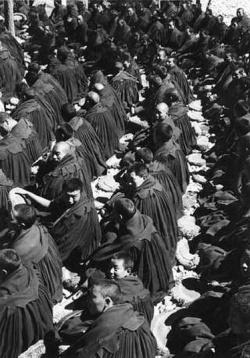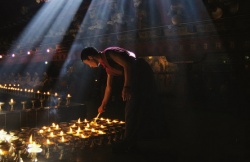Difference between revisions of "History of Tibet – A Few Chapters"
| Line 130: | Line 130: | ||
| − | [[Jamgon Kongtrul Lodro Thaye]] wrote, “In this [[world]] of Jamudvipa, [[Guru Rinpoche]] is known as just one [[nirmanakaya]] who tames [[beings]], but according to the different capacities and giftedness of [[people]] he is [[perceived]] in various ways. The {{Wiki|history}} of the [[Oral Transmission]] of [[Kilaya]] and most [[Indian]] sources explain that he was born as the son of a [[king]] or a minister in [[Uddiyana]]; while the [[terma]] [[treasures]] for the most part narrate that he was miraculously born. In some texts he is said to have appeared from a bolt of {{Wiki|lightning}} at the | + | [[Jamgon Kongtrul Lodro Thaye]] wrote, “In this [[world]] of Jamudvipa, [[Guru Rinpoche]] is known as just one [[nirmanakaya]] who tames [[beings]], but according to the different capacities and giftedness of [[people]] he is [[perceived]] in various ways. The {{Wiki|history}} of the [[Oral Transmission]] of [[Kilaya]] and most [[Indian]] sources explain that he was born as the son of a [[king]] or a minister in [[Uddiyana]]; while the [[terma]] [[treasures]] for the most part narrate that he was miraculously born. In some texts he is said to have appeared from a bolt of {{Wiki|lightning}} at the summit of Mount Malaya. Each of these wondrous stories differs in many ways. This is indeed a topic that lies far [[beyond]] the reach of an ordinary person’s intellect.”7 |
[[Sogyal Rinpoche]] tells us about [[Padmasambhava]], “As [[Buddha]] himself was passing away, he prophesied that [[Padmasambhava]] would be born not long after his [[death]] in [[order]] to spread the teachings of the [[Tantras]]. It was [[Padmasambhava]] who established [[Buddhism]] in [[Tibet]] in the eighth century.” Furthermore, “For us [[Tibetans]], [[Padmasambhava]], [[Guru Rinpoche]], [[embodies]] a [[cosmic]], timeless [[principle]]; he is the [[universal]] [[master]]. He has appeared countless times to the [[masters]] of [[Tibet]], and these meetings and visions have been precisely recorded: the date, the place, and the [[manner]] in which they occurred, along with the teachings and {{Wiki|prophecies}} [[Padmasambhava]] gave. He also left thousands of [[visionary]] teachings for future times, which have been revealed again and again by the many great [[masters]] who have been his [[emanations]]; one of these [[visionary]] [[treasures]], or [[termas]], is the [[Tibetan]] [[Book]] of the Dead.”8 | [[Sogyal Rinpoche]] tells us about [[Padmasambhava]], “As [[Buddha]] himself was passing away, he prophesied that [[Padmasambhava]] would be born not long after his [[death]] in [[order]] to spread the teachings of the [[Tantras]]. It was [[Padmasambhava]] who established [[Buddhism]] in [[Tibet]] in the eighth century.” Furthermore, “For us [[Tibetans]], [[Padmasambhava]], [[Guru Rinpoche]], [[embodies]] a [[cosmic]], timeless [[principle]]; he is the [[universal]] [[master]]. He has appeared countless times to the [[masters]] of [[Tibet]], and these meetings and visions have been precisely recorded: the date, the place, and the [[manner]] in which they occurred, along with the teachings and {{Wiki|prophecies}} [[Padmasambhava]] gave. He also left thousands of [[visionary]] teachings for future times, which have been revealed again and again by the many great [[masters]] who have been his [[emanations]]; one of these [[visionary]] [[treasures]], or [[termas]], is the [[Tibetan]] [[Book]] of the Dead.”8 | ||
Revision as of 12:25, 14 December 2013
Dedicated to the long life, good health, and beneficent activities of
His Holiness the Seventeenth Karmapa, Ugyen Trinley Dorje,
His Eminence Jamgon Kongtrul Rinpoche, Lodro Choyi Nyima,
Venerable Khenchen Thrangu Rinpoche,
His Eminence Sangye Nyenpa Rinpoche,
who never tire of teaching and helping whenever called,
and all those who simply care, each in his and her own way.
A major contribution to the cultural heritage of Tibet occurred when King Songtsen Gampo had a written script for the Tibetan language invented to unify the Tibetan people inhabiting the land between Bactria and Han China and between Nepal and East Turkestan. He also may have wanted to rule over Zhang Zhung, the ancient province with its capital near Mt. Kailash (Ti-se). King Songtsen Gampo welcomed Buddhism to Central Tibet through the influence of his Chinese and Nepali wives, who – it is recorded – persuaded him to wear silk instead of sheepskin. According to accounts, King Songtsen Gampo sent his trusted minister Thonmi Sambhota (the “Good Bhota” or “Tibetan” who was born approximately 610 in Yorwo Lunggu) to Khotan to find a script and grammar that would suit the language of Central Tibet.
Khotan was the flourishing Buddhist Kingdom on the Silk Road that ran along the southern edge of the Taklamakan Desert in the Tarim Basin. The Swedish geographer Sven Hedin discovered the buried city of Khotan in the 1890s. The Buddhist sites between Khotan and Dunhuang were excavated during four expeditions between 1900 and 1930 by the Hungarian archaeologist Sir Mark Aurel Stein, who noticed the early ties between the Kushan Dynasty (or Indo-Scythians), whose capital was near Bamian, and the inhabitants of Khotan. Stein also found evidence in both the 7th century writings of Hsuan-tsang and old Tibetan texts that Khotan had been conquered and colonized about 200 B.C. by immigrants from Taxila in the Hindukush. Hsuan-tsang learned from early accounts that many chieftains from Taxila founded a kingdom in the Tarim Basin. They were the people, he reports, who introduced Buddhism to Khotan. He wrote, “What land there is, is suitable for regular cultivation and produces of fruits. The manufactures are carpets, haircloth of a fine quality, and fine-woven silken fabrics. Moreover, it produces white and green jade. (…) They have knowledge of politeness and justice. (…) They love to study literature and arts. (…) The country is renowned for its music.” [1] Khotan’s success was dependent upon China, trade along the Silk Road, and the proliferation of Buddhism. It suffered greatly when all three declined. In the 10th century the Tang Dynasty in the east and invasions by Arabs in the west weakened the region. While the east-west trade continued, the once flourishing Buddhist shrines were destroyed by the Islamic culture.
East of Tibet, the oldest caves of Dunhuang date back to the 4th century A.D. It is said that a Buddhist monk had a vision of 1000 Buddhas and began carving grottoes into the sandstone cliff and to fill them with Buddhist images at the edge of what are called the Dunes of Singing Sands, “Mingsha Shan” in Chinese. Over the next thousand years, hundreds of similar caves were cut into the same rock face. One cave contained a sealed library whose contents reflect contacts with early major Buddhist centres of both Central Asia and the Chinese empire. Dunhuang began to decline in the 12th century. Jeanne Lasen formulated the remarkable discoveries in her book Silk Road: “In some of the caves rest the fruits of human effort to render in two dimensions a universe made up of four: (…) written words. Some are Sanskrit, some in Chinese, Tibetan or Uigur or Nepalese or Persian with Hebrew letters. This welter of words marks silk, leather, palm leaves from the very homeland of the Buddha , paper made of bamboo pulp and mulberry bark.”2
Another flourishing centre of Buddhism east of Tibet was the Tangut Kingdom, slightly west of Dunhuang. The people spoke a language similar to Tibetan but created their script based on Chinese. In the 13th century the Mongolian ruler invaded the Tangut Province and encouraged the conversion to Islam, which brought the end of Buddhism and the northern Silk Road.
Latri Khenpo Nyima Dakpa wrote,3 “The Bon religion has existed in this world for 18,000 years. Yungdrung Bon originated as the teaching of Tonpa Shenrab in Olmo Lung Ring (an enlightened realm). From there the teachings spread to Zhang Zhung and from there throughout most Asian lands.” The assassination of Emperor Ligmincha of Zhang Zhung at the end of the 8th century by King Trisong Detsen “(…) ended Zhang Zhung’s independence. Thereafter, Zhang Zhung’s land and culture were assimilated into Tibet, and they eventually disappeared.” Latri Khenpo continued, “The Zhang Zhung language had three different scripts. (The) Tibetan script was derived from the Zhang Zhung mar yig scripts. Many Tibetan and western scholars believe that there was no written language before the time of Songtsen Gampo (…). Bon scholars do not accept this view, holding that its proponents have not adequately researched the early origins or the Tibetan language and the history of Tibet.” Furthermore, “Bon practitioners were typically given the choice of converting from Bon to Buddhism, leaving Tibet, or being put to death.” Latri Khenpo also tells us, “Most of the Bon teachings have been translated from the Zhang Zhung language into Tibetan.” In early times, the Kingdom of “Zhang Zhung was the closest neighbouring land to Tibet, extending from what is known today as the upper part of north-western Tibet, through parts of Nepal and Northern India (Kashmir, Ladakh, Zamskar, Kinnaur, Spiti, etc.) to Pakistan (Kashmir) and China (the Karakoram area).”4 In the website about Dieter Schuh’s microfilm collection of Bonpo texts published by the Nepal German Project on High Mountain Archaeology in 2001, Karl-Heinz Everding points to the fact that Bon is a neglected field in Tibetan studies and writes that its “(…) doctrinal treatises, ritual texts, chronicles and biographies of important scholars, to mention only a few important branches of its vast literature, remain for the most part still unexplored. Since large parts of its literature are available only with great difficulty, the collection of Bon po texts, microfilmed by Dieter Schuh during his visit to the Bon po monastery of sMan ri, Doljani (India), in 1969 is of special importance. The unique scholarly significance of these films is that they maintain the manuscripts in exactly the state in which they arrived from Tibet.”5
It is said that in order to find a script and grammar that would suit the language of Central Tibet and unite the empire, Thonmi Sambhota (approx. 610-650 A.D.) travelled from Yarlung in Central Tibet through Kashmir in the west to reach Khotan. When he arrived, he learned that Master Li Byhin (Li the Tibetan term for “Khotan”) was in Kashmir, so he had to undertake the tedious journey back to meet him there. Orthographic analysis reveals that the Tibetan alphabet actually follows features distinctive to Kharosthi, which is derived from the Indian Upright Gupta script. Alexander Berzin points out that historical accounts mistake the place of composition by claiming that Tibetan is based on the Kashmiri alphabet.6
King Songtsen Gampo used the new script for the translation of a Sanskrit Buddhist text that the kings of Yarlung had received from India centuries earlier. The main translations were of astrology and medical texts. Furthermore, the king needed a written language to send military messages to his armies in the fields and to record own oral traditions. During the reign of the next emperor, Tibetans began to import and translate select Buddhist texts. Yet, it was only through the power of King Trisong Detsen, the spiritual presence of Padmasambhava, and the vast knowledge of Shantarakshita that Buddhism became the national religion.
In the introduction to the Tibetan-English Dictionary, Sarat Chandra Das quotes H.A. Jaeschke, who had also written a Tibetan-English dictionary in 1881: “His (Thonmi Sambhota’s) invention of the Tibetan alphabet gave two-fold impulses: for several centuries the wisdom of India and the ingenuity of Tibet laboured in unison and with the greatest industry and enthusiasm at the work of translation. The tribute due to real genius must be accorded to these early pioneers of Tibetan grammar. They had to grapple with infinite wealth and refinement of Sanskrit; they had to save the independence of their own tongue, while they strove to subject it to the rule of scientific principles, and it is most remarkable how they managed to produce translations at once literal and faithful to the spirit of the original.”7
In the 8th century Vairocana Lotsawa, born in the sNye-Mo area and known as “one of the seven gifted monks of Samye” was sent to India by Padmasambhava to bring teachings to Tibet. Later he supervised translations of Buddhist texts on a large scale.8 David Snellgrove and Hugh Richardson note that the number of monks in the monasteries of Eastern Tibet were quite small and wrote, “(…) there is similar evidence from Central Tibet, where the traditional number of original ordinands was just seven, and where a stone pillar recording the foundation of a temple at lCang-bu (in sTod-lung) by the noble family of Tshes-pong mentions provision for only four monks.”9
The Tibetan script is sacred since it was created for the translation of Buddhist texts. Several alphabets developed; two principal types are the block letters known as U-chen (“with head”) and U-med (“without head”). The first is used in books and printed documents, the latter for more worldly matters. Gyud-yig is the cursive script and Bam-yig the script used for book titles. The Ranjana script for the Kalachakra monogram is a stylised version of the Indian Lantsa script. Lantsa is reserved for sacred texts that line both walls and pillars in temples.
The Tibetan alphabet consists of 30 basic consonants, with the vowel a inherent to each, and four vowels on the Sanskrit model for i, u, e, and o. Now a monosyllabic language, most words are spelled with a complexity of initial consonants as fixed in the times of the early kings and were presumably once pronounced, e.g. bsgrubs (“established”) is pronounced in the dialect of Central Tibet, simply trub. Remembering that a is inherent to every consonant in question, aggs (“refuted”) is pronounced gag. When an n, l, d, or s follow a letter that isn’t marked by an i, o, u, or e, then the other vowels become umlaut, e.g. rgyl is pronounced gyael (“victorious”), spun is pronounced puen (“brother”), skd is pronounced kae (“language”), sdug.bsnl is dug-nael (“suffering”), brgyd is gyae (“eight”), examples that illustrate the difference between the way words are spelled and pronounced. A Tibetan saying goes, “Half of the words are read by implication.” The advantage of maintaining the written form is that once sufficiently skilled in reading, it is easy to decipher texts on stone pillars and manuscripts that date back as far as the 8th century.
The vast literature of Tibet was meticulously translated with immense accuracy and comprises all Buddhist religious works of India, including the great collections of the Kangyur, “The Translation of Lord Buddha’s Words,” and Tengyur, “The Translations of Teachings.” The Kangyur is a collection of Sanskrit classics that trace their origin to the spoken word of Buddha Shakyamuni and contains over 1000 books in about 100 volumes of woodblock prints. The Tengyur is a collection of approximately 3,500 books written mostly in Sanskrit during the period from about 200–1000 A.D., texts that explain the books of the Kangyur and other subjects such as literature, linguistics, science, architecture, painting, and medicine. The Tengyur also includes the entire section of the Madhayamaka and Cittamatrin, Prajnaparamita and Pramana philosophies, Vinaya as well as the Abhidharmakosha (which was written by Vasubhandu in the 4th century A.D.), along with extensive explanations. Unlimited editions were translated from Tibetan into Mongolian, Manchurian, and Chinese, evidence that Tibetan was “the lingua franca of Higher Asia”10 and that Tibetan scholars generously took part and encouraged an enriching dialog with both neighbours and friends.
Tibetan is an ergative language that follows the subject-object-verb order.11 Spoken Tibetan - today an extremely endangered language - is divided into three registers: Phal-skad (the vernacular speech); Shes-sa (the respectful style spoken particularly in the area of Lhasa, in the meantime called “the high dialect or Lha-sa”); and Chos-skad (the literary style for scriptures and classical works). There are several dialects: dBus spoken in Central Tibet; gTsang in the area of Gyantse and Shigatse; Khams in Sichuan, Gansu, and Yunnan; Amdo in the area of Qinghai; rDzong-kha is the language of Bhutan; Shar-pa is spoken by the Sherpas who live in north-east Nepal; Lo-skad is the dialect spoken in Mustang.
King Songtsen Gampo & the Ramoche Lhakhang
King Srong-brtsan-sgam-po (born approx. 609 and died 650)1 succeeded the throne of his father gNam-ri-slong-mtshan around 627 A.D. as the 33rd ruler of Yarlung and founder of the Tubo Dynasty.2 The Yarlung Empire stretched from the borders of Bactria to those of Han China and from Nepal to the borders of East Turkestan. He is credited for the first transmission of Buddhism to Tibet. His grandson, Myang-mang-po-rje, expanded the Tibetan territory through the plains of India to the frontiers of China and Zhang Zhung. Berzin wrote, “In order to stabilize political alliances and his own position of power, Songtsen-gampo married princesses first from Zhang-zhung and then, late in his reign, from Tang China and Nepal. After wedding the Zhang-zhung princess, he had her father, Lig-nyihya (Lig-myi-rhya), the last Zhang-zhung king, assassinated. This allowed the focus of native ritual support of the imperial cult to shift to himself and his rapidly expanding state.”3
Songtsen Gampo took Princess Bhrikuti Devi from Nepal as wife. Her father, Anshuvarrnan, was king of the Licchavi Kingdom, which existed in the Kathmandu Valley from about 400-750. She is said to have converted him to Buddhism, and the marriage helped establish Buddhism as the state religion. Songtsen Gampo built the Jokhang Temple, then called Rasa ‘phrul-snang in Tibetan, “magical apparition of Rasa (the old name for Lhasa),” to house the Akshobhya Buddha she brought as dowry, the reason why the main gate faces westward to Nepal. Queen Bhrikuti Devi is known as Pelsa, “Land of Wool (referring to Nepal),” in Tibetan.
Having been refused Princess Wengcheng Kongjo as bride in 634, he attacked and defeated the people who lived around Lake Koko Nor in Amdo and was therefore able to control major trade centres along the northeastern Silk Road into China. After a successful campaign against China in 635, Emperor Taizong of the Tang Dynasty agreed to the marriage and thus friendship with China was stable.4 Princess Wengchen left her homeland to marry King Songsten Gampo in 640 and arrived a year later. She is said to have converted him to Buddhism too, and the marriage firmly established Buddhism as state religion. The Ramoche Temple in Lhasa was constructed due to her efforts to house the Jobo Buddha she brought as dowry, the reason why the main gate faces eastward to China. Queen Wengchen is known as Gyasa, “Expansive Land (referring to China),” in Tibetan.
Both queens were Buddhists and therefore changed the course of Tibetan history. Dzongsar Khyentse Rinpoche wrote, “Songtsen Gampo’s two queens can be credited for a great part of his cultural awareness. Bhrikuti (…) brought the traditions of Himalayan Buddhism. Princess Wengchen (…) brought a treasure trove of ancient Chinese wisdom. She travelled across the steppes to her husband with a collection of Chinese classic literature and texts on sacred astrology, geomancy, and medicine.
“Many obstacles lay in Princess Wengchen’s path as she headed to Yarlung. She had a vision of a gargantuan demoness who lay sprawled across the Himalayas, so large that one limb lay in Paro, Bhutan and another lay in Western Tibet. When she arrived in Yarlung, she shared her vision with her new husband. Recognizing the value of the treasures that his bride brought to him, as well as the importance of her vision, King Songtsen Gampo commissioned thirteen demoness-subjugating temples across the land, built over the demoness’ vital organs, ankles, wrists, and torso, forever binding her from wreaking havoc. The Lhasa Jokhang was built over her heart centre, where it still resides. Other such temples are Trenduk Lhakhang in Tsetang and Paro Kyichu in Butan.”5 Berzin wrote, “(…) it is difficult to ascertain what level of Buddhist teachings and practice were introduced. It was undoubtedly very limited, as would have been the case with the Zhang-zhung rites.”6
One may not neglect the small temple that Princess Wengchen erected before she arrived at the Imperial Court in Yarlung. The small temple is situated approx. 10km away from the Thrangu Monastery in the Yushu County of Kham in East Tibet, home of the source of the three Asian rivers, the Yellow River (called Hwang-Ho in Chinese), the Yangtze Kiang, and the Mekong. The Thrangu Monastery has thrived over a thousand years; the Wengchen Temple is more than 1300 years old. Both have been the source for the spread of Buddhism in Kham and especially of the Karma Kagyu teachings. The very auspicious place is indeed situated in a pure land where emanations of Amitabha Buddha and Nagarjuna have manifested.
King Songtsen Gampo had Buddhist temples built around geomantic sites in Tibet and Bhutan but did not found monasteries. Berzin wrote that „(...) the major one was constructed eighty miles from the imperial capital, at the site that later became known as ‘Lhasa’ (Lha-sa, The Place of the Gods). At that time, it was called ‘Rasa’ (Ra-sa, The Place of the Goats). Western scholars speculate that the Emperor was persuaded not to build the temple near the capital so as not to offend the traditional gods.7 It is unclear who manned these Buddhist temples, but presumably they were foreign monks. The first Tibetan monastics did not ordain until nearly a century and a half later.”8 Berzin continued, “Further evidence of Songtsen-gampo’s policy of using foreign invention to boost his political power is his adoption of a written script for the Tibetan language. Taking advantage of Zang-zhung’s long history of cultural and economic relations with Khotan, Gilgit, and Kashmir, the Emperor sent a cultural mission, led by Tonmi Sambhota (…) to the region.”9 Khyentse Rinpoche, “No Tibetan translations of the Buddhist scriptures existed and it was Songsten Gampo who instructed his minister Thonmi Sambhota to travel to India, study Sanskrit, and develop a Tibetan script. He then commissioned the translation of several thousand texts.”10
Khyentse Rinpoche tells us, “As a reminder of the great empire that Songtsen Gampo ruled, a large pillar still stands before the Potala in Lhasa, erected during his reign, on which is inscribed the agreement between the Tibetan and Chinese rulers to respect each other’s borders. He studied Chinese, became skilled in the art of leadership, and most importantly, he adopted sacred codes of conduct from Buddhist scripture. Under his rule, sacred practices began to replace the shamanistic practices (…).” He continued, “Songtsen Gampo meditated for several years in a cave that is now at the core of Potala palace.”11
King Songtsen Gampo died in 650. He played a decisive role by introducing Buddhism to Tibet, which explains why he is revered so deeply and is considered a human emanation of Avalokitshvara.12
The following oath indicates the strength and stability of royal authority at that time:
Never will we be faithless to King Song-tsen-gam-po, to his sons and his descendants!
Never ever at any time will we be faithless to the King and his offspring,
whatever we do!
Never will we seek other overlords among other men!
Never will we interfere with food and mix poison with it!
Never will we address the first word to the King!
If one of our offspring, male or female, acts faithlessly,
never will we not confess that such a one is faithless!
Never shall our sons befriend those who are faithless!
If we perceive that anyone else is faithless to the King, never will we not confess it!
Never shall there be calumny or envy towards our comrades who are without fault!
If we are appointed as officials,
never will we act unfairly towards those who are subject to us!
Never will we be disobedient to whatever command the King may give.13
Ramoche Lhakhang
Ramoche Lhakhang was erected by King Songtsen Gampo to house both the Akshobhya Buddha that Princess Bhrikuti Devi brought to Tibet when they married in 632 and the Jobo Buddha that Princess Wengchen brought when they married in 641. Legend says that the work completed on the temple each day was mysteriously undone each night, until the demoness who exerted negative influences was appeased. It is said that after her husband’s death Queen Wengchen took the sacred Jobo out of Ramoche Lhakhang and hid it from an impeding Chinese invasion in the Jokhang, where it is today and remains the most venerated and visited shrine in Tibet. She buried the Akshobhya Statue outside the city walls.
Khyentse Rinpoche praises the king with these words, “Without Songtsen Gampo there would be no Tibetan alphabet, Lhasa would have no Jokhang, and the supreme demoness of Central Tibet might still be roaming the earth unfettered. (…) Through his enlightened leadership, the path was cleared for the dharma to be propagated throughout the provinces, and for Buddhism to flourish.”14
The Jokhang in Lhasa
After the age of vacuity had elapsed at the end of the previous age,
Winds arose from the ten directions, creating a configuration in the shape of a cross;
Rain fell from a cloud, and amidst a mass of water,
A thousand lotuses were seen; thus the Fortunate Age was proclaimed.
-- Jamgon Kongtrul Lodro Thaye the Great
The seeds of Buddhism were introduced to Tibet through the influence of Songtsen Gampo’s two wives. Buddhism became fully established by King Khri-srong-lde-brtsan, who ruled throughout the second half of the 8th century, and King Khri-gtsug-lde-brtsan (Ral-pa-chen), who ruled from approx. 815-836. Until the final eclipse of Buddhism in India at the end of the 12th century, the Tibetans were visiting Nepal and India for texts, instructions, and initiations, committing themselves whole-heartedly by then. The holiest testimony is located in the centre of Lhasa and was built by King Songtsen Gampo approx. 647.8 David Snellgrove and Hugh Richardson wrote, “(…) the Jo-khang itself was certainly founded by Srong-brtsan-sgam-po, for it is specifically mentioned and ascribed to him under its old name ‘Phrul-snang or Ra-sa in several ancient inscriptions. Also ascribed to him are the Ra-mo-che and Khra-‘brug chapels, as well as twelve ‘boundary and limb-binding’ chapels, supposedly built to bind and subdue the anti-Buddhist demons of Tibet. The authenticity of these traditions has been questioned by some Western scholars, but if the Jo-Khang is accepted as a seventh century foundation, there is no good reason to reject the others out of hand.”9
Pure are your eyes, broad and beautiful,
like the petals of a blue lotus.
Pure is your thought, having discovered
the supreme transcendence of all trances.
Immeasurable is the ocean of your virtues,
the accumulation of your good deeds.
You affirm the path of peace.
O Great Ascetic, obeisance to you! -- Licchavi Ratnakara
The Jokhang contains the most sacred shrine of the “Precious Lord,” Jobo Rinpoche, Yeshe-Norbu in Tibetan, which is one of the most revered images in Tibet. Jobo Rinpoche represents Buddha Shakyamuni and is believed to have been crafted during his life, when he was twelve years old, by Vishvamkarma with the guidance of Indra.10 It originally belonged to the King of Magadha in India.11 He gave it to Emperor Taizong of the Tang Dynasty. His daughter, Princess Wengchen Kongjo, brought it to Tibet as a present when she married King Songtsen Gampo.
It is said that Princess Wengchen chose the site of the Jokhang through divination and astrological calculations. Legend also says that Songtsen Gampo threw his ring into the sky, promising to build a temple where it landed. The ring fell into a lake and struck a rock where a white stupa miraculously appeared. The king had the lake filled with stones and invitede craftsmen from Tibet, Nepal, India, Kashmir, and China to erect the Jokhang Temple over the pool. Even today, a pool exists under the main courtyard.
The Ramoche Lhakhang, situated near the Jokhang, was built to house Jobo Rinpoche; the Jokhang was built to house the Akshobhya Buddha brought to Tibet by Princess Bhrikuti Devi from Nepal.12 It is said that after her husband’s death, Queen Wengchen took the sacred Jobo Statue out of Ramoche Lhakhang and hid if from an impeding Chinese invasion in the walls of the temple that later became known as the Jokhang, the “Home of Jobo.” Two generations later, the Chinese bride of the 36th Tibetan King, Me-‘gtsom, enquired about the whereabouts of the Buddha image. It was found and placed in the shrine of the Jokhang, where it is today and remains the most venerated and visited shrine in Tibet. The image of the Akshobhya Buddha originally placed in the Jokhang was buried on the outskirts of Lhasa, so the images were interchanged after they were found again.
The Jokhang has undergone many reconstructions and additions, especially during the reign of the Fifth Dalai Lama in the 17th century, but it retains a basic lay-out similar to early chapels and contains very early woodwork, especially the lion beam ends and the carved capitals of some of its pillars. Snellgrove and Richardson wrote, “(…) business ventures added greatly to the wealth of the temples and provided a channel through which cultural and artistic influences might enrich daily life and thought. Pearls and other precious stones, brocades and richly worked robes, incense-burners and ritual vessels, gilded bronze and copper images found their way into the monasteries. (…) One remarkable survival from the period (of the 14th century) was a great scroll, fifty feet long by two and a half feet wide, describing in five languages, beautifully written in gold, the miraculous events of a visit to the emperor by the fifth Karmapa hierarch. The events are illustrated by panels delicately painted by a Chinese artist.”13 Tibetan art and architecture was always inspired by native, Indian, Nepali, as well as Chinese cultures.
Sarat Chandra Das, who wrote a Tibetan-English dictionary in 1902, described the first period of Tibetan history as “the Period of Translations, which may also be entitled the Classical Period, for the sanctity of the religious message conferred a corresponding reputation and tradition of excellence upon the form in which it was conveyed. This period begins in the second half of the seventh century A.D., when Thon-mi Sambhota (the good Bhota or Tibetan), the minister of King Srongtsen Gampo, returned to Tibet after studying the Sanskrit language under an eminent Brahman teacher of Magadha.” Chandra Das continued, “The Classical Period may be divided into three stages. The first or the earliest stage terminated with the downfall of the first historical monarchy when King Langdarma fell by the hand of an assassin.” Chandra Das quoted Jaschke, author of a first Tibetan-English dictionary, “The second period corresponds with this stage, when ‘Tibetan authors began to indulge in composition of their own’ and wrote on historical and legendary subjects.”1 Ken Holmes added, “The threefold power of Trisong Detsen’s royal patronage, Padmasambhava’s spiritual presence and Abbot Shantaraksita’s vast knowledge enabled Buddhism to take a firm hold in Tibet. It was declared to be the national religion, and most importantly, the great monastic complex of Samye was constructed and the first monks were ordained.”2
King Khri-srong-lde-brtsan (Trisong Detsen, 742-798 A.D.) contributed greatly to establishing Buddhism in Tibet. During his reign, the prosperous cities along the Silk Road came under Tibetan rule, although the repeated invasions along the Chinese frontiers were minor conquests. He invited the Indian Pandit and Bodhisattva Abbot Shantarakshita to Tibet to speak about dependent origination and the ten virtuous actions and to build the first monastery at Samye near Mt. Hepori. Shantarakshita was “(…) the founder of the philosophical school combining Madhyamika and Yogacara.”4 There was a smallpox epidemic at that time. The conservative faction in the court blamed Shantarakshita and deported him from the land. On the abbot’s advice, the king invited Padmasambhava, known as Guru Rinpoche, from Swat, which is situated in the north of Pakistan, to drive out the spirits who had caused the smallpox. The emperor later asked Shantarakshita to return, which he did.5 Snellgrove and Richardson noted that “These two teachers represent two rather different forms of Buddhist practice, the one conventionally academic and monastic, and the other mystical and ritual.”6
Jamgon Kongtrul Lodro Thaye wrote, “In this world of Jamudvipa, Guru Rinpoche is known as just one nirmanakaya who tames beings, but according to the different capacities and giftedness of people he is perceived in various ways. The history of the Oral Transmission of Kilaya and most Indian sources explain that he was born as the son of a king or a minister in Uddiyana; while the terma treasures for the most part narrate that he was miraculously born. In some texts he is said to have appeared from a bolt of lightning at the summit of Mount Malaya. Each of these wondrous stories differs in many ways. This is indeed a topic that lies far beyond the reach of an ordinary person’s intellect.”7
Sogyal Rinpoche tells us about Padmasambhava, “As Buddha himself was passing away, he prophesied that Padmasambhava would be born not long after his death in order to spread the teachings of the Tantras. It was Padmasambhava who established Buddhism in Tibet in the eighth century.” Furthermore, “For us Tibetans, Padmasambhava, Guru Rinpoche, embodies a cosmic, timeless principle; he is the universal master. He has appeared countless times to the masters of Tibet, and these meetings and visions have been precisely recorded: the date, the place, and the manner in which they occurred, along with the teachings and prophecies Padmasambhava gave. He also left thousands of visionary teachings for future times, which have been revealed again and again by the many great masters who have been his emanations; one of these visionary treasures, or termas, is the Tibetan Book of the Dead.”8
Padmasambhava9 was “incarnated as an 8 year-old child appearing in a lotus blossom on Lake Dhanakosha (…). The local king who married him to one of his daughters, Mandarava, recognized his special nature. Padmasambhava’s other main consort, Yeshe Tsogyal, developed into realized practitioner. Padmasambhava’s ability to memorize and comprehend esoteric texts in a single hearing established his reputation as a master above all others. Accused of mystical killing of an evil minister, he was banished from the court. (…) Trisong Detsen, whose kingdom was beset by evil mountain deities, knew his fame. The king invited Padmasambhava to Tibet where he used his tantric powers to subdue the evil deities he encountered along the way. (…) This was in accordance with the tantric principle of not eliminating negative forces but instead redirecting them to fuel the journey toward spiritual awakening. In Tibet he founded the first monastery in the country, Samye Gompa, and introduced the people to the practice of Tantric Buddhism.”10
Jamgon Kongtrul Lodro Thaye tells us, “King Trisong Detsen requested empowerment and instruction from Padmakara. At Chimbu, the hermitage above Samye, the great master disclosed the mandala (…) into which he initiated nine chief disciples including the king. Each of them was entrusted with a specific transmission and all nine attained siddhi through practicing the respective teaching. Padmakara gave numberless other profound and extraordinary teachings connected with the three inner tantras to many destined students headed by the king and his sons and the twenty-five disciples in Lhodrak, Tidro, and many other places.
“Guru Rinpoche remained in Tibet for 55 years and 6 months; 48 years while the king was alive and 7 years and 6 months afterwards. He arrived when the king was 21. The king passed away at the age of 69. Padmakara stayed for a few years after that before leaving for the land of the rakshas. (…)
“Knowing that a descendant of the king would later try to destroy Buddhism in Tibet, he gave many predictions for the future. Conferring with the king and the close disciples, Padmakara concealed countless terma teachings headed by the 8 personal treasures of the king, the 5 great mind treasures, and the 25 profound treasures. The reasons for hiding these termas were to prevent the teachings of Secret Mantra to be destroyed, to avoid that the Vajrayana be corrupted or modified by intellectuals, to preserve the blessings, and to benefit future disciples. For each of these hidden treasures Padmakara predicted the time of the disclosure, the person who would reveal them, and the destined recipients who would hold the teachings.”12 Bodhisattva Shantarakshita could continue his work and was able to initiate seven monks before he died in 783; they were Tibet’s first Buddhist monks who gradually established the Noble Sangha and have come to be known as “The Seven Examined Men.”
Repeated battles took place between Tibet and China. In 783 a peace treaty was signed which established the boundary between the two countries. Tibetan military forces were making headway in the west, though. The army advanced as far as the Pamirs, until the Arabian Caliph, Harun al-Rashid allied himself with the Chinese. The Tibetans were able to hold their own. Berzin added, “(…) in 784, a grand persecution and exile of the Bonpos took place. Most went to Gilgit or Yunnan. According to the traditional Bon account, Zhang-zhung Drenka-namka buried the Bon texts at this time for safekeeping.”13 Berzin continued, “Historical and political analysis reveals that the reason for the exile was suspicion that the xenophobic conservative Zhang-zhung political faction might assassinate the Emperor for being pro-Indian, as it had done to his father. Moreover, the state kept the Bon burial rituals and sacrifices. Therefore, it is reasonable to conclude that it was a persecution of the Zhang-zhung political faction, not a persecution of the Bon religion.”14 It has been noted that “the very fact that nothing less than the coalition of the two most powerful empires of the early Middle Ages was necessary for checking the expansion of the Tibetan state, is a magnificent witness of the political capacities and military valour of these sturdy mountaineers.”15
During this period, Tibet had become ground for differing schools of thought. King Trisong Detsen therefore followed Khenpo Shantarakshita’s advice and invited the Indian Pandit Kamalashila to present the Indian Buddhist school and the famous Chinese Monk Hvashang Mahayana to present the Chan school (Jap. Zen) in a debate at Samye. The debate lasted from 792-794. It is recorded that Kamalashila swirled his sleeve around in the air, inferring the question, “What is the source of samsara?” Hvashang covered his head, indicating that ignorance is the source of samsara. Kamalashila won what has become known as “The Great Debate at Samye” and Hvashang had to leave the country. Thrangu Rinpoche tells us that Kamalashila introduced the gradual Mahayana path, which is practiced to this day by all lineages of Tibetan Buddhism. The king asked Kamalashila to compose a text explaining the stages of meditation. One of the most important texts Kamalashila wrote is the Bhavana-krama, which delineates krama, “the sequence,” of meditation practice.
King Trisong Detsen sent Vairocana, one of the seven initiated monks, to India to search out more teachings. He brought back both Dzogchen and Buddhist medicine Tantra texts, supervised translations on a large scale, and invited the Indian Dzogchen Master Vimalamitra to bring more texts. Shortly after the great debate at Samye, Vairocana “was exiled after Indian abbots slandered him for revealing too much, so he buried more Dzogchen texts, as did the Indian Vimalamitra.”16
After signing a peace treaty with China in 821, Emperor Ralpachen “(a Buddhist fanatic) made the Samye abbot the head of the State Council. He decreed that seven families support each monk in Tibet. He also formed a council to authorize terms to be included in a large Sanskrit-Tibetan compendium of translation terms he commissioned. (…) No tantra terms were included. (…) Most likely due to the excesses of Emperor Ralpachen, his successor and older brother, Emperor Langdarma closed monasteries and persecuted monks from 836-842. The Buddhist libraries and the (…) lay tradition, however, were preserved. The first buried Bon treasure texts were recovered by accident at Samye in 913.”17 Langdarma was assassinated in 846, but members of the royal family had fled to West Tibet earlier and built their castles there. The period of the first recorded kings of Tibet had come to an end.
Samye Gompa, the first Buddhist monastery in Tibet, was built by both the saint and precious master Padmasambhava as well as the abbot and scholar Shantarakshita during the rule of King Trisong Detsen (742-798 A.D.).2 At that time, Samye was called Nechen, which means “the great location.” One of the most accomplished of the “seven examined men” first ordained at Samye Gompa was Bodhisattva Vairocana, who saw the smaller site near the capital of Lhasa and called it Nechung, which means “the smaller location.” He prophesied, “A monastery will be built here because the small lake and tree nearby are possessed by Pehar.” Berzin wrote, “The rock mountain behind the monastery has a footprint of Guru Rinpoche Padmasambhava and a naturally formed crossed vajra.”3
The Government of Tibet in Exile wrote of a legend that there was a monastery known as Tsal-gang-thang on the other side of the Kyichu River flowing east of Lhasa. A custodian in charge of a shrine in Tsal-gang-thang got into a feud with the leading spirit Pehar Gyalpo and packed him inside a box he planned to throw into the river. Lama Chang-chub Palden, caretaker at Tsal-gang-thang, saw what was happening and commissioned his attendant to get hold of the box and bring it back, forbidding him to open it. The next morning the attendant saw the box floating toward him in the river. He seized it and wanted to carry it back to his Lama, but the box became heavier and heavier as he neared the monastery. He put it down and, curious to see what was inside, lifted the lid. A pigeon flew out and disappeared in a nearby tree. The attendant remembered his master’s words and sighed, “May the Lama know!” These words were later inscribed on the rock where he placed the box and can still be seen. The attendant returned to his Lama, told him what happened, and Lama Chang-chub Palden exclaimed, “It shows that the location is too small to house this powerful spirit.” Lama built the first monastery there and a community of monks established Nechung Gompa.4
“Pehar Gyalpo was bound to oath by Padmasambhava to head the entire hierarchy of protective spirits and Dorje Drakden6 was Pehar’s principal emissary to Tibet.”7 It is said that Buddhism spread extensively with the help of Dorje Drakden during the reign of both King Trisong Detsen, who ruled throughout the second half of the 8th century, and his son, Mu-ne-btsan-po, who ruled at the end of the 8th century.
In the History of the Nechung Monastery it is stated, “Nechung originally came to Tibet with a descendant of the Indian sage Dharmapala. Dharmapala is the Sanskrit term for “defender of the religious law,” translated into Tibetan as Drag-gshed, “cruel, wrathful hangman.” They are Hindu gods introduced to Tibetan Buddhism by Padmasambhava. Most monasteries have their own Dharmapala. In iconography, they are depicted as frightening beings with many heads, hands, or feet and have a fierce expression with protruding fangs. Nevertheless, they are Buddhas, Bodhisattvas, or Dharmarajas (Damchen in Tibetan) who embody compassion that manifests in a fierce way. Damchen were once mountain spirits who were bound under oath to protect the Dharma by Guru Rinpoche and other Buddhist saints during the transmission of Buddhism from India to Tibet. The eight Dharmapalas are: Mahakala, Yama, Yamantaka, Hayagriva, Kubera, Palden Lhamo, Changpa, and Begtse.8 During the reign of King Trisong Detsen, “Pehar was appointed protector of Samye by (…) Padmasambhava.”9
The story of Pehar can be read in Himalayanart, summarized: Many eons ago he was born as a prince to Damaraja of Asura country. Another boy was born as a minister’s son, and they became good friends. Both young men became monks. Prince Damaraja’s religious name was Dawe Shinu, “riding the moon,” his friend’s religious name was Tunten Nagpo. Dawe Shinu became a scholar, who enjoyed teaching Dharma; his friend preferred meditating. One day Dawe Shinu visited a Hindu Temple where he met a beautiful girl. Strong desire arose in him and they made love in the temple for an entire week, so he broke his vows of celibacy. Tunten Nagpo showed up and tried to stop them but couldn’t. Dawe Shinu was so furious that he turned himself into a lion and tried to kill his friend for interfering. Vajrapani protected Tunten Nagpo with his vajra, so nothing more harmful happened.
Dawe Shinu died and was reborn in hell, where he suffered immensely. After time spent there, he was reborn as a very poor and homeless human. While wandering around he met his former friend Tunten Nagpo in another incarnation, but they did not get along. After his death, Dawe Shinu was born in the family of King Muche Tsampo and Queen Lumo Tongon. His name was Vajra Kuhe Samati. Again, Tunten Nagpo in a next birth was meditating in a cave. Vajra Kuhe Samati turned himself into a rat and tried to disturb his former friend. Again Vajrapani protected Tunten Nagpo.
Then Vajra Kuhe Samate was born as the third of Dudje Tsempo’s five sons; Dudje was king in the realm of the ancient demons. Vajra Samate’s name was Mudu Tankhar. Pehar is a reincarnation of Mudu Tankhar. He has three faces, six arms, and rides a lion. He is known as a king of action. When Guru Rinpoche and Shantarakshita built Samye Gompa, Guru Rinpoche invited Pehar to come from his Palace Petahor. Guru Rinpoche gave him a wife, Mentsun Karmo, as well as a girlfriend. They built a palace for Pehar in the northern side of Samye Gompa, called Peharchok and known as the Turquoise Palace; it still exists. Guru Rinpoche invited other deities as well and built many temples for them around Samye.10 Furthermore, “There are numerous legends concerning the subjugation of Pehar, however all state that he is not indigenous to Tibet. Oath-bound to protect the Buddhist teachings by Guru Padmasambhava, he has since become a Tibetan national protector, a Dharmapala, predominantly practiced by the Nyingmapa.”11
The principal architect of Nechung Gompa was the Fifth Dalai Lama (1617-1682) and the monastery was completed “in honour of the Oracle in 1683. (…) A number of vessels through which Pehar could be contacted were moved from Nechen to Nechung”12 - from Samye to Nechung. And “the government held monks of Nechung Gompa responsible for keeping daily contact with Pehar. Many traditions of rituals were practiced there, such as the Treasure Doctrine of Nyang Nyima Odzer.”13 Berzin explained this clearly, “The Fifth Dalai Lama was a great revealer of Nyingma treasure texts. The set of 25 deity practices of the gSang-ba rgya-can, Bearing the Seal of Secrecy, derive from his pure visions. The Fifth Dalai Lama (…) introduced them (…) to the Nechung Monastery (…).” Berzin continued, “The Fifth Dalai Lama (…) took up the Northern Treasure Text Tradition from Dorjey-drag (Nechung), since the holders were blood descendants of the great religious kings of Tibet. Guru Rinpoche Padmasambhava had advised that if this lineage were not supported and upheld, it would be detrimental to Tibet.”14
Returning to what he summarized as “the threefold power of Trisong Detsen’s royal patronage, Padmasambhava’s spiritual presence and Abbot Shantarakshita’s vast knowledge,” Ken Holmes described the situation during these times clearly, “The early glory of this tradition lasted for some sixty years, until the hostile (and probably insane) monarch Langdarma destroyed the majority of its vestiges. Although it did gradually re-establish its monasteries and sangha, it had to vie at first with the animist religion for influence and then later with the new lineages (sarma) arising from the work of Atisha, Marpa and other eleventh century renovators. It was during that period that the tradition became referred to as the ‘ancient’ (mying.ma) school.”15
The hostile multitudes are vast as space –
What chance is there that all should be subdued?
Let but this angry mind be overthrown
And every foe is then and there destroyed. -- Shantideva
All photos of Tibet taken in 1986 and written
by Gaby Hollmann (2006)
[1] Website: athenpub.com, 2005.
2 Website: Hundred-threshold-systems, 2005.
3 Nyima Dakpa, Introduction.
4 Nyima Dakpa, p. 128.
5 Website: tibetinstitut.de/page ID, 2006.
6 See the website of Alexander Berzin, in: berzinarchives.com, 2005.
7 H.A. Jaeschke, in: Sarat Chandra Das, A Tibetan-English Dictionary with Sanskrit Synonyms, The Bengal Secretariat Book Depot, Calcutta, 1902; 7th reprinted edition by Rinsen Book Co., Japan, 1985, pages vii-viii.
8 See Ken Holmes, in the website: samyeling.org, 2005.
9 David Snellgrove & Hugh Richardson, p. 90.
10 Sarat Chandra Das, page ix.
11 Compare: en.wikipedia.org/wiki/Tibetan_language.
1 Rangjung.com/authors/King_Songtsen_Gampo (2006) states that he lived from 569-650 or 617-650.
2 Alexander Berzin wrote that he was the 32nd ruler of Yarlung; compare berzinarchieves.com/e-books/historic_interaction, 2006.
3 Berzinarchirves.com/e-books/historic_interaction. Nyima Dakpa wrote that the last king of Zhang-Zhung, Ligmincha, was killed by the 37th king of Tibet, Trisong Detsen, at the end of the 8th century; see Latri Khenpo Nyima Dakpa, Opening the Door to Bon, p. 14.
4 The kingdom started waning because of a power struggle that weakened the Yarlung court and its military presence along its borders; it arose between Khri-‘dus-srong (approx. 677-704) and his ministers and when Tibet allied itself with the Eastern Turks against Tang China in 703.
5 Dzongsar Khyentse Rinpoche, King Songtsen Gampo, in: The Great Patrons of Buddhism Series, part V, Khyentse Foundation Communique, winter 2004-2005.
6 Berzinarchives.com/dzogchen/brief history, 2006. See especially Bernhard Kolver & Siegfried Lienhard (eds.), Heritage of the Kathmandu Valley. Proceedings of an International Conference in Lubeck 1985, published by the International Institute for Tibetan and Buddhist Studies, Halle, Germany, in: Nepalica, vol. 4, 1987.
7 The capital of the Tubo Dynasty was at Yumbu Lhakhang and ‘Phyong-rgyas in the Yarlung Valley, gh.
8 Berzinarchives.com/e-books/historic_interaction. See the chapter on “Early Kingdoms on the Tibetan Plateau,” above.
9 Berzinarchives.com/dzogchen. See also “Written Tibetan – Spanning Time” here.
10 Dzongsar Khyentse Rinpoche.
11 Dzongsar Khyentse Rinpoche.
12 See also Rangjung.com/authors/King_Songtsen_Gampo, 2006.
13 Dunhuang chronicle, in: David Snellgrove & Hugh Richardson, pp. 27-28.
14 Dzongsar Khyentse Rinpoche.
1 See “Written Tibetan – Spanning Time” here.
2 Tibetanpen.org/manjushri, 2006.
3 Dzongsar Khyentse Rinpoche.
4 Answers.com/topic/emperor-taizong-of-tang, 2006.
5 Countrystudies.us/Nepal/5, 2006. A people prior to the Licchavi have been identified as the Kirata. Factbites.com (2006) notes that “The Licchavi period saw to the flourishment of Hinduism and Buddhism in Nepal. Excellent examples of Buddhist art of the period are the half-sunken Buddha in Pashupatinath, the sleeping Vishnu in Budhanilkantha, the statue of Buddha and the various representations of Vishnu in Changu Narayan.” The Licchavi dynasty declined in the late 8th century and was followed by the Newari era.
6 See the chapter “King Songtsen Gampo & Ramoche” here..
7 Berzinarchives.com/r-books/historic_interaction, 2006. For a detailed discussion, see the chapter “Early Kingdom on the Tibetan Plateau” here.
8 See the chapter “King Songtsen Gampo & Ramoche” above.
9 David Snellgrove & Hugh Richardson, p. 73. Khra-‘brug is located in Yarlung.
10 In the Vedic times, Indra was the supreme ruler of the gods. “He was the defender of mankind against forces of evil. He had early aspects of a sun-god, riding a golden chariot across the heavens, but is more often known as the god of thunder, wielding the celestial Vajra, the lightning bolt. (…) He shows aspects of being a creator god, having set order to the cosmos, and since he brought water to earthe was a fertility god as well.” Stephen T. Naylor, Encyclopedia Mythica, in the website of Pantheon.org, 2006. -- “Vishvakarma, the divine architect and weapon maker (…), is believed to have created the chariots of the gods. He was the father of Sanjana who married Surya (the solar deity) but could not bear his splendour. Ultimately, Vishvakarma removed 1/8th of Surya’s effulgence and created Lord Shiva’s trident, Lord Vishnu’s discus and other fabulous weapons.” India Heritage, in the website of Indiaheritage, Sept. 2004.
11 Magadha was one of the four main kingdoms of India at the time of Buddha Shakyamuni. The core of the kingdom was that portion of Bihar that lies south of the Ganges, with its capital at Rajagriha. Buddha was born as a Prince of Kapilavastu in Kosala, which had been annexed by the Kingdom of Magadha at that time. Therefore Magadha was the scene of many incidents in his life.
12 See “King Songtsen Gampo & Ramoche” here.
13 David Snellgrove & Hugh Richardson, p. 156.
1 Sarat Chandra Das, pp. vii-viii.
2 Ken Holmes, Samyeling.org/Buddhism. See Alexander Berzin, The Reigns of the Following Two Tibetan Emperors and The Rule of Empresses, in: Berzinarchives.com/e-books, 2006.
3 Sogyal Rinpoche, in the website: Rigpa.com, 2006.
4 Rangjung.com/authors, 2006.
5 See Alexander Berzin, as well as the website: Tibet.com/3kings, 2006.
6 David Snellgrove & Hugh Richardson, p. 78.
7 Jamgon Kongtrul Lodro Thaye, Rinchen, Terdzo, “The Great Treasury of Precious Termas,” vol. 1, translated by Erik Pema Kunsang, Rangjung Yeshe Publications, Boudhanath, 1990. In Rangjung.com: “Rinchen Terdzo is a collection of the most important revealed termas of Padmasambhava, Vimalamitra, Vairotsana and their closest disciples, gathered by Jamgon Kongtru Lodro Thaye with the help of Jamyang Khyentse Wangpo. Published in 63 volumes by His Holiness Dilgo Khyentse Rinpoche, New Delhi, India, with the addition of several more volumes of termas and commentaries. Khakyab Dorje, the 15th Karmapa, described it in these words: ‘The great Treasury of Precious Termas is the quintessence of the ocean-like teachings of the sugatas (buddhas), the profound Vidyadhara Pitaka of the Early Translation School.’” See the website of Rangjung.com/authors; especially the book, Lotus-Born: The Life Story of Padmasambhava. Foreword by His Holiness Dilgo Khyentse Rinpoche, translated by Erik Pema Kungsang, Rangjung Yeshe Publications, Boudhanath, 2000. (Mt. Malaya in Maghalaya, East India?)
8 Sogyal Rinpoche. See also Sogyal Rinpoche, The Tibetan Book of Living and Dying, Harper, N.Y., 1993.
9 Padmasambhava (also Padmakara or Padma Raja, Tibetan Padma Jungne), in Sanskrit meaning “Lotus Born,” founded the Tantric school of Buddhism in the 8th century. In Bhutan and Tibet he is known as Guru Rinpoche, “Precious Master,” where followers of the Nyingma School regard him as the Second Buddha. The Root Guru in Tantric Buddhism is a spiritual master who has achieved enlightenment, therefore he or she is a Buddha’s earthly representative. It is the Root Guru who transmits the Buddha’s teachings, which is the reason why Tantric Buddhism holds the Root Guru in highest esteem. Describing the Root Guru as the embodiment of the Three Jewels is logical and appropriate.
10 Wikipedia.org/Padmasambhava, 2006.
11 David Snellgrove & High Richardson, p. 78.
12 Jamgon Kongtrul Lodro Thaye, Rinchen, Terdzo, “The Great Treasury of Precious Termas,” vol. 1.
13 Concerning the name Drenka-namka, Tenzin Wangyal Rinpoche mentioned it and wrote, “The great 8th century Bon master and sage Dranpa Namkha, father of the Lotus born Guru Padmasambhava (…) embraced the new religion in public but maintained his Bon practice and allegiance in private in order secretly to preserve Bon. He asked the king, ‘Why do you make a distinction between bon and chos?’ (The word bon for the Bonpos and chos for the Buddhists both mean ‘dharma,’ or ‘truth’), since he held that in essence they were the same.” Tenzin Wangyal Rinpoche, Wonders of the Natural Mind, Snow Lion Publ., N.Y., 2000, p. 45.
14 Alexander Berzin, in: Berzinarchives.com/dzogchen, 2006. See also the chapter “Early Kingdoms on the Tibetan Plateau” here.
15 Luciano Petech, quoted in the website: Tibet.com/3kings, 2006.
16 Alexander Berzin.
17 Alexander Berzin.
1 Dilgo Khyentse Rinpoche, The Heart Treasure of the Enlightened Ones, Shambhala Publ., 1992, p. 166.
2 See the chapter “Samye Gompa” here.
3 Alexander Berzin, A Brief History of Dorjey-drag Monastery, in the website: Berzinarchives.com/history_Buddhism, 2006.
4 See the website of the Office of Tibet in London: Tibet.com/nechung_his, 2006.
5 Padmasambhava, in the website: Himalayanart.org/image, 2006.
6 Nechung.
7 Nechung Foundation, N.Y.C., History of the Nechung Monastery, in the website: Nechungnyc.org, 2006.
8 See the site: Wikipedia-org/Dharmapala, as well as Encyclopedia Britannica, in: Britannica.com, 2006.
9 Nechung Foundation.
10 Summarized from: Worldly Protector (Buddhist) – Pehar, in the website: Himalayanart.org/image, 2006. See also Pehar, in the website: Khandro.net/deity_wrathful, 2006.
11 Himalayanart.org/image.
12 See the website of the Office of Tibet in London.
13 Nechung Foundation.
14 Alexander Berzin, A Brief History of Dorjey-drag Monastery.
15 Ken Holmes, Eight Chariots and Four Lineages, in the site: Samyeling.org/Teachers/KenHolmes/8chariots, 2006.
